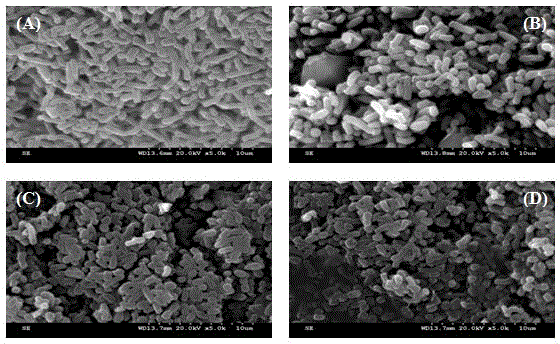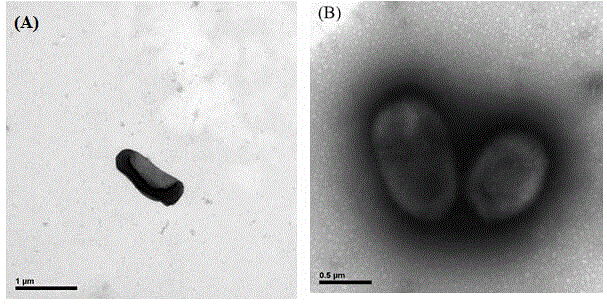VBNC biphenyl degrading bacterium isolation and screening method and application
A technology for separating, screening, and degrading bacteria, applied in the field of microbial degradation of pollutants, can solve the problems of difficult separation of bacteria, low degradation efficiency, and lack of efficient degradation bacteria, and achieve the effects of low cost, easy access to raw materials, and easy operation
- Summary
- Abstract
- Description
- Claims
- Application Information
AI Technical Summary
Problems solved by technology
Method used
Image
Examples
Embodiment 1
[0037] Embodiment 1: the preparation of accelerator SRpf
[0038] 1. Source of strains: Micrococcus Luteus IAM14879 can be purchased from the Micrococcus Luteus Culture Collection Center of RIKEN.
[0039] 2. LMM medium: 4.0g / L NH 4 Cl, 1.4g / L KH 2 PO 4 , 0.005g / L biotin, 0.02g / L L-methionine, 0.04g / L vitamin B1, 1.0g / L inosine, 0.03g / L MgSO 4 , 8.75g / L L-lithium lactate, 1.5ml / L mineral salt solution (0.375g / L CuSO 4 ·5H 2 O, 0.785g / L MnCl 2 4H 2 O, 0.18g / L FeSO 4 ·7H 2 O, 0.029g / L Na 2 MoO 4 2H 2 O, 0.089g / L ZnSO 4 ·7H 2 O), the pH is 7.5.
[0040] 3. Pre-fermentation: M.luteus was inoculated on LMM plates from inclined test tubes, and cultured at 30°C for 3 days. Pick 3 rings of M.luteus lawn into a 250mL Erlenmeyer flask filled with 50mL LMM liquid medium, culture at 30°C, 160r / min, for 36h.
[0041] 4. Fermentation culture: take the seed culture liquid and transfer it into a 50 mL Erlenmeyer flask containing 15 mL of LMM culture liquid according to the ino...
Embodiment 2
[0043] Example 2: Enrichment screening and isolation and purification of VBNC biphenyl degrading bacteria
[0044] 1. Source of sediment: The sediment used to isolate VBNC biphenyl-degrading bacteria was taken from a PCB-contaminated area in Luqiao District, Taizhou City, Zhejiang Province.
[0045] 2. Screening culture medium: there are two kinds of screening culture medium, namely the treatment group and the control group, and the promoter SRpf is added to the inorganic salt medium at a volume fraction of 10% to obtain the treatment group culture medium. The culture medium of the control group was the inorganic salt medium without the promoter SRpf. Wherein the composition of the inorganic salt medium is: 1-2g / L of KH 2 PO 4 , K of 2.5-3.5g / L 2 HPO 4 ·3H 2 O, 0.2g / L MgSO 4 , 0.02g / L FeSO 4 ·7H 2 O, 1g / L NaCl, 2-4g / L (NH 4 ) 2 SO 4 , 0.01g / L CaCl 2 , 2mL / L trace salt solution (4mg / L MoO 3 , 28mg / L of ZnSO 4 ·5H 2 O, 0.02mg / L CuSO 4 ·5H 2 O, 4 mg / L of H 3 BO ...
Embodiment 3
[0048] Example 3: Among the VBNC biphenyl-degrading strains, the screening, molecular identification and naming preservation of strain TG9
[0049] 1. Screening of strain TG9: The 11 strains unique to the treatment group were compared with the existing strains for 16S rRNA gene sequence, phenotype, and chemical characteristics, and a new strain TG9 different from the existing strains was screened out.
[0050] 2. Strain TG916S rRNA gene sequence: (1) Use the DNA extraction kit (UNIQ-10 Column Bacterial Genomic DNA Extraction Kit) to extract bacterial DNA and amplify the 16S rDNA of the strain. The 50 μL PCR reaction system includes: EasyTaq SuperMix: 25 μL, 1 μL each of primers 8F (5'-AGAGTTTGATCCTGGCTCAG-3') and 1541R (5'-AAGGAGGTGATCCAGCCGCA-3'), template DNA 2 μL, deionized water: 21 μL. The PCR reaction conditions were: pre-denaturation at 95°C for 4 min, denaturation at 95°C for 3 min, annealing at 53°C for 30 s, extension at 72°C for 1 min, and 30 cycles, final extension...
PUM
| Property | Measurement | Unit |
|---|---|---|
| tolerance concentration | aaaaa | aaaaa |
Abstract
Description
Claims
Application Information
 Login to View More
Login to View More - R&D
- Intellectual Property
- Life Sciences
- Materials
- Tech Scout
- Unparalleled Data Quality
- Higher Quality Content
- 60% Fewer Hallucinations
Browse by: Latest US Patents, China's latest patents, Technical Efficacy Thesaurus, Application Domain, Technology Topic, Popular Technical Reports.
© 2025 PatSnap. All rights reserved.Legal|Privacy policy|Modern Slavery Act Transparency Statement|Sitemap|About US| Contact US: help@patsnap.com



